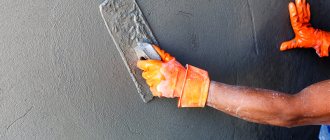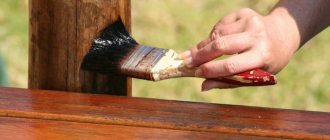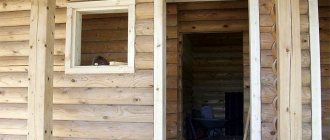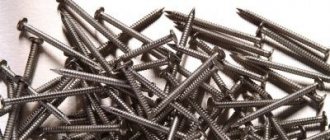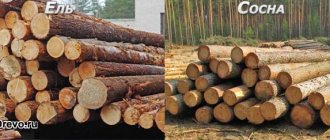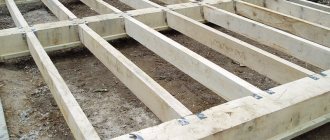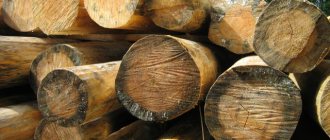Wood is the oldest building material; along with its many advantages, this material has its own “Achilles heel” - wood is susceptible to negative factors. Under the influence of moisture, wood swells and changes geometric dimensions; excess moisture creates favorable conditions for the development of harmful microorganisms that damage wood. Destructive processes occur when exposed to solar ultraviolet radiation; under the influence of sunlight, wood loses its elasticity and strength, changes color, and microcracks form.
In each historical era, different methods were used to protect wooden buildings; in the 20th century, the use of physical and chemical methods of protection came first. The wood material is pressed, boiled in chemical solutions, and treated with protective impregnations. One of the modern means of processing is liquid glass; wood processing with liquid glass is used by professional builders and private developers.
The need to protect wood
Timber used in frame buildings and roofing of buildings is characterized by hygroscopicity. They absorb moisture from the air, become damp, mold and gradually lose their strength. The destructiveness of the external environment on wooden structures depends on:
- from increased moisture content in environmental conditions;
- on the amount and volume of precipitation;
- on the rate of decay;
- from the likelihood of fire;
- from exposure to chemicals;
- from wood-boring insects.
The use of liquid glass prevents the adverse effects of dampness and other factors, and extends the service life of wooden structures. It is advisable to use the coating composition in those areas that are most exposed to moisture:
- in basements and office premises;
- in places where condensation accumulates from heating and ventilation systems;
- in attics where moisture penetrates during rain;
- on floor beams regularly exposed to precipitation.
Liquid glass is not absorbed into wood. When the product is applied to the surface, a protective layer is formed, which serves to waterproof the building material and disinfect it as an antiseptic. This eliminates the likelihood of pathogenic microflora developing in the wood structure and moisture getting inside it.
How meaningful is wood processing and how to carry it out?
It is recommended to apply a product such as liquid glass not to everything, but only to those wood structures that are not planned to be painted. The thing is that if a wooden house is treated with silicate glue for protection, it will be almost impossible to paint it.
This is explained by the fact that the wood becomes mirror-smooth and, accordingly, the water-repellent functions increase many times over. It is best to impregnate with the product those wooden structures that are located:
For example, elements such as beams and rafters. Other places with possible high humidity. If it is necessary to protect wood more productively, liquid glass becomes irrelevant and for this it is necessary to look for other means.
It is important to note the fact that when treating wood with liquid glass, you should ensure that the coating thickness is at least 100 microns. Otherwise, such waterproofing will be of little use.
Characteristics of liquid glass
The second name of the substance is silicate glue. It is an aqueous solution of sodium or potassium silicates. During electrode coating, this composition is replaced by lithium silicates. The material was first obtained back in the 19th century. Now there are several ways to manufacture a product industrially. Its parameters depend on the ratio of components that do not affect quality. However, for some applications, a certain composition is preferred.
Liquid glass, which has an alkaline reaction, dissolves in water. Acidity ranges from 10 to 13. The saturation and consistency of the composition is determined by its concentration, temperature and ratio of elements. Sodium-based material turns into a liquid state at temperatures above 600 degrees. The thickened film of sodium silicate can be dissolved by water, and under the influence of humidity and carbon dioxide contained in the air, it loses its properties.
Thanks to its waterproofing, thermal insulation and fire retardant properties, the product is used in numerous areas:
- production of building materials resistant to acids and water;
- special impregnation of fabric surfaces;
- production of fire-resistant paint;
- strengthening loose soils.
Silicate glue is used to glue cellulose materials. It is used in the production of electrodes and in the drilling process.
Important! According to the instructions, the product is incompatible with organic substances, except sugars, alcohol and urea.
Advantages and disadvantages
Any building material has strengths and weaknesses. Scientists have not yet come up with the ideal substance. Knowing the advantages and disadvantages, you can choose the scope of application. In addition, this information attracts many buyers. Liquid glass has the following strengths:
- high adhesion - the substance easily penetrates even the most inaccessible places, thereby strengthening it and protecting it from moisture penetration;
- after hardening, a smooth surface is formed - any type of liquid glass can be applied well to any material, provided that the instructions are followed;
- profitability - when processing building materials, 2 times less liquid glass is used than any other waterproofing composition;
- low cost.
Specifics of working with liquid glass
Real protection from moisture is achieved by covering the silicate adhesive with a layer of 0.1 mm or more. You should first familiarize yourself with the rules for working with a chemical that can lead to individual skin sensitivity, irritation of the respiratory system and thermal injuries to the eyes. That is why safety precautions must be observed when working with this material. Typically used preventatives:
- special work gloves;
- individual mask;
- eye protection glasses;
- overalls
When working, you will need a brush or roller, as well as a grinding tool to pre-clean the surface.
Preparation of wood treatment product
The industry produces primer silicate adhesive in liquid form. The consistency of jelly is considered the norm. The thicker structure of the product will not allow it to be absorbed into the wood - it will simply harden on the surface. As a result, the protective properties of silicate glue are lost. Different manufacturing companies produce a product of varying thickness.
Before use, depending on the initial viscosity, the product is diluted with water according to the instructions: usually two, three or four times. Experienced specialists are able to determine the degree of dilution with great accuracy.
Wood processing process
Priming of wood is carried out in the temperature range from -20 to +40 degrees. To ensure the required thickness of the liquid glass coating (100 microns), there must be at least two layers of the product. The second layer is applied after the first one has completely dried.
The work consists of performing the following steps:
- familiarization with the manual;
- compliance with temperature conditions;
- organization of personal safety;
- leveling the working surface;
- diluting silicate glue with tap water.
Apply diluted sodium silicate to a leveled, sanded surface using a paint roller or a voluminous brush, allow it to dry completely and coat with the product again. If necessary, the procedure should be repeated.
The consumption of the composition is related to the quality of the surface being primed: the better it is polished, the less material is consumed to cover it. On the contrary, for a less smooth flooring, the product cost will increase. The hardening time of liquid glass is determined by the purity of the solution or the additives included in its composition. It ranges from 10 minutes to half a day. Fire retardants contain the most additives.
Attention! Typically, freshly made wood flooring is treated. This increases its durability, preserves the natural shades and visual appeal of the material.
Application as waterproofing
Liquid glass is used as waterproofing of foundations, plinths, basements, walls and ceilings, artificial reservoirs, etc. The method for preparing the required mixture is indicated in the instructions. Exact compliance with the conditions will help ensure reliable waterproofing. Execution order:
- the surface is cleaned of dust and dirt, and also degreased with a solvent. If it is concrete or metal surface, it is recommended to use a wire brush to open the pores;
- Using a brush, liquid glass is applied to the surface. After drying, the next layer is applied;
- After the newly formed waterproofing has completely hardened, finishing work is performed.
Product selection
The structure, density and cost of the material depend on the method of its production and the components used. According to the most elementary method, the substance is obtained from silicon-containing raw materials combined with an alkaline mixture at certain values of pressure and temperature.
There are several types of liquid glass for dissimilar surfaces. Before choosing a product, you usually get acquainted with its characteristics and determine its suitability for the desired coating. For wood surfaces, sodium silicate adhesive is usually used. You should study the information on the packaging:
- where the products were made;
- shelf life;
- precautionary measures.
Manufacturers
Three samples of the product are optimal for coating wood:
- "Expert" production is a sodium product. It is designed to increase the durability and reliability of wood, protecting it from moisture, mold, mildew, fire and wood-boring insects. The product is non-toxic, does not contain solvents, has no pungent odor, is ready for use - does not require dilution, and can withstand freezing without loss of quality. The time for complete drying at 20 degrees and normal humidity is about a day.
- Translucent liquid glass "Omega" with a sodium composition is produced in the finished form of St. Petersburg. The product is characterized by the absence of solvents. It protects wood well from the effects of negative natural factors and fire.
- An aqueous alkaline solution of sodium silicates from Kubanzheldormash is a viscous light gray liquid. The product provides a durable, light-resistant coating with dirt-repellent and fire-retardant properties.
Sodium silicate is used in areas exposed to aggressive natural factors - outside and inside buildings. Coating wood with liquid glass is effective for extending the life of the material, protecting it from the harmful effects of environmental factors and preserving the appearance of the structure.
Meaning of the term
Liquid glass is created by mixing potassium and sodium silicates, with the addition of special plasticizers and modifiers that improve performance properties. After hardening, a transparent layer forms on the surface. After a visual inspection, we can say that the surface is fragile, but this is not the case. Special modifiers penetrate deeply into concrete, which helps protect the building material from moisture and mechanical damage. The cost of liquid glass is significantly lower than that of similar mixtures. Liquid glass is easy to apply, so anyone can handle this procedure.
READ Which wood is better to cover a steam room in a bathhouse?
Coating wood with 1 layer of liquid glass
A building material such as wood is characterized by increased hygroscopicity. Because of this, wood tends to become damp, as a result of which it loses up to half of its actual original strength. Another negative point is that the tree is a fire hazard. In addition, wood is a favorite habitat for a wide variety of insects, mold, fungi and bacteria. For these reasons, it is not advisable to use wooden structures in construction and repairs without proper protection of the material, which includes treatment with liquid glass.
Pouring the flooring
In bathrooms, showers, bath rooms and indoor swimming pools, which are characterized by constant humidity and wet floors, flooring can be made using liquid glass. To fill the floor you need:
- if wooden floors are laid, then first make a concrete screed; pour silicate solution onto the dried surface in equal portions; level the adhesive layer with a wide spatula; carry out the final leveling of the 3-5 mm thick layer using a squeegee; after the silicate layer has dried, apply a finishing coat of varnish ( polyurethane or epoxy would be better).
It is worth considering that it is impossible to decorate a floor already covered with liquid glass. When pouring a concrete screed, the floor surface will have a corresponding “concrete” color and texture.
Decorating the floor must be done before applying a layer of liquid glass. Alternatively, you can paint the concrete. At the same time, it is recommended to add a small amount of silicate to paints and varnishes to improve their adhesion to concrete. After the paint has dried, you can fill the floor according to the above algorithm. By the way, taking into account the non-toxicity of the material, its heat and water resistance, it can be used to treat a steam room, which is most often made of wood and can be subjected to constant exposure to moist hot air without proper care deformation.
Feasibility of wood processing
The use of silicates for wood processing is justified in many cases. Impregnated wood is more durable and fire-resistant, while maintaining decorative properties and the wood texture is clearly visible.
Manufacturers offer a variety of liquid glass for wood; the use of the mixture has been practiced for two centuries. Modern lumber manufacturing technologies do not exclude such additives during the production process. ZhS is used for processing finished wooden buildings made of boards, foundations made of solid wood (solid timber, round timber, sleepers). Novice builders will be able to process wood with liquid glass when constructing private houses, bathhouses, and outbuildings.
In terms of the effectiveness of protecting wood from moisture, liquid glass coatings are superior to films of paints and varnishes; liquid glass is much cheaper and more practical.
Liquid glass is used to process all kinds of frames and various structures that are subject to intense exposure to negative factors. It is recommended to use silicate mixtures for impregnation:
- Cover crowns;
- Rafters;
- Roof elements;
- Lag for installing the floor;
- Wooden piles;
- grillage;
- Structural elements of wells.
If you treat the walls of basements and cellars, fungus and mold will not develop. The coating is a reliable protection of wood from rotting due to temperature changes and condensation formation. Verandas, terraces and gazebos covered with liquid glass are preserved under the influence of precipitation and ultraviolet radiation. It is recommended to treat places where sewer and water pipes are laid in wooden buildings.
After application to the surface, liquid glass fills unevenness and cracks, and structural stabilization of the wood occurs. A film is formed on the surface that does not allow moisture to pass through.
The coating retains its protective properties for up to 10 years. Then the tree needs to be covered with resin again.

